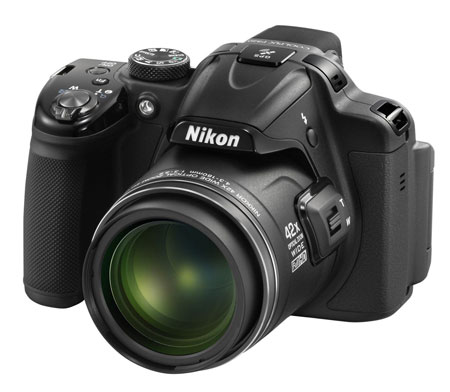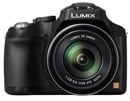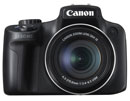Nikon COOLPIX P520
-
-
Written by Ken McMahon
Verdict
The Nikon COOLPIX P520 is a 42x superzoom with an 18.1 Megapixel sensor. It supercedes the 16 Megapixel COOLPIX P510, which is still available. With some exceptions, notably Panasonic, manufacturers tend to update super-zoom lenses every couple of generations and so the COOLPIX P520 and the earlier P510 share the same 4.3-180mm (24-1000mm equivalent) f3-5.9 lens.
Beyond the new sensor the new model boasts a bigger 3.2 inch screen that folds out and can face in any direction. A built-in GPS receiver, 0.2 inch 201k dot electronic viewfinder, and built-in flash are all retained from the older model. As are the PASM shooting modes, Scene modes, special effects, panorama mode and the video modes including the 1080p25 18.8Mbps best quality HD mode and a range of reduced resolution high speed modes that slow down the action by up to 4x.
The older P510 was already well equipped with a wide range of options for movie shooting, but it’s disappointing that Nikon hasn’t taken his opportunity to improve the P520’s full resolution continuous shooting speed, though to be fair it does provide plenty of reduced resolution options. And the camera’s sluggishness, especially when shooting video is another issue that’s been overlooked. So aside from bigger prints, and the ability to crop, which effectively provides the same field of view at the same reolution as the 12 Megapixel PowerShot SX50 HS, the new sensor doesn’t bring any other benefits.
Despite those criticisms, the COOLPIX P520 is a step forward from the P510 and though owners of the older model won’t be in a rush to upgrade, newcomers to the super-zoom market will be attracted by it’s big fold out screen and the small advantage its newer sensor provides. Before my final verdict, let’s see how it compares to the Panasonic Lumix FZ70 / FZ72 and the Canon PowerShot SX50 HS.
 |
Compared to Panasonic Lumix FZ70 / FZ72
The most noticeable thing that sets these two models apart, to the casual observer at any rate, is size. For a super-zoom model the Lumix FZ70 / FZ72 is on the large side, after all, it has a 60x zoom lens inside it. The COOLPIX P520 on the other hand is small. Neither of these cameras is ever going to fit in your pocket, but looking at the COOLPIX P520 you’re just a little bit tempted to give it a try.
Both have plastic bodies, the Shiny exterior of the COOLPIX P520 is attractive, but may not stand up to bumps and scratches as well as the more business-like exterior of the Lumix FZ70 / FZ72. So much for the external differences, on the inside the COOLPIX is fitted with an 18 Megapixel sensor, though in practical terms the extra 2 Megapixels over the Lumix FZ70 / FZ72 is likely to make little difference (though it does allow you to get closer to the 1200mm maximum zoom of the FZ70 / FZ72 by cropping) and in my test the image quality and noise performance of the two were quite closely matched.
The COOLPIX P520’s 42x zoom lacks the reach of the 60x zoom on the Lumix FZ70 / FZ72 at both ends of the range, but it’s still a huge zoom and will more than do the job for most people. It also has a zoom rocker switch on the lens barrel, which the FZ70 / FZ72 lacks. But if you really must have the biggest zoom available and value ultra-wide view angles as much as the super-telephoto focal lengths the Lumix FZ70 / FZ72 really can’t be beat.
The COOLPIX P520 has a slightly bigger screen than the Lumix FZ70 / FZ72 and you can angle it in pretty much any direction you choose including forward-facing for self-shooting. The Lumix FZ70 / FZ72’s screen is fixed in position, but its EVF, is a little bigger and brighter than the COOLPIX P520’s and it has a button for toggling the view between the viewfinder and EVF. Both models have a built-in flash, though the Lumix FZ70 / FZ72’s is more powerful, plus you can fit an external flash unit in the FZ70 / FZ72’s hot shoe; the COOLPIX P520 doesn’t have a hot shoe, so you’re limited to the built-in flash.
Both models of course offer PASM shooting modes, as well as scene modes and a range of effects, though the COOLPIX P520 lacks the FZ70 / FZ72’s popular miniature mode. It also lacks its range of customisation options, with only one programable function button. Though neither model excels at continuous shooting the COOLPIX P520 provides longer burst shooting at a slightly slower rate and more versatile reduced resolution burst modes. And if you like to shoot RAW, that won’t be a problem on the FZ70 / FZ72, but the COOLPIX P520 lacks a RAW mode.
Both have a dedicated movie record button and allow you to make use of the optical zoom during recording. But the Lumix FZ70 / FZ72 offers a wider range of movie modes in addition to full PASM control over exposure.The Lumix FZ70 / FZ72 runs for twice as long on a fully charged battery, 400 shots compared with half that number on the COOLPIX P520, but the latter has a built-in GPS receiver that can automatically tag images with positonal data.
Depending on where you are in the World, these two models can be quite closely matched for price. If they’re both on your wishlist you’ll need to think carefully about which provides the best balance of features for you. The long zoom range, better customisation, hot shoe, RAW shooting and more versatile movie modes are strong selling points for the FZ70 / FZ72, for the COOLPIX P520 it’s compactness, the bigger flip-out screen and built-in GPS.
See my Panasonic Lumix FZ70 / FZ72 review for more details.
Compared to Canon PowerShot SX50 HS
The PowerShot SX50 HS, like the Lumix FZ70 / FZ72 has a broader zoom range than the COOLPIX P520, but though it outreaches it at the telephoto end it has the same 24mm equivalent wide angle. The other major difference between these two models is the sensor resolution; the COOLPIX P520 has 50 percent more pixels on its 18.1 Megapixel sensor compared with 12 Megapixels on the PowerShot SX50 HS. That not only means you can make bigger prints; if you crop a photo taken at the COOLPIX P520’s maximum 1000mm equivalent telephoto zoom down to the same 12 Megapixel resolution of the PowerShot SX50 HS, you get pretty much the exact same field of view. What you don’t get though is the superior image quality and low noise characterstics of the PowerShot SX50 HS.
The PowerShot SX50 HS has a relatively small 2.8 inch 460k dot LCD, compared with a visibly more expansive 3.2 inch screen on the COOLPIX P520 with a higher resolution of 921k dots which gives a more detailed view. Both are articulated with a side hinge allowing versatile positioning including front-facing for selfies and folded in for protection when not in use. Both models have similar electronic viewfinders, in terms of specifications at least, with 0.2 inch, 201k dot panels, but the PowerShot SX50’s viewfinder looks a little bigger in practice.
Personally, I found the PowerShot SX50 HS a better camera from a handling perspective. It responds to the controls more rapidly, offers two custom positions on the mode dial and has buttons for helping frame your subject when fully zoomed in, which is a big help when operating at the upper limits of the zoom range.
Both cameras have a dedicated movie record button and are able to use their optical zooms during recording. The COOLPIX P520 offers a best quality 1080p25/30 option compared with 1080p24 on the SX50 HS. Neither offers PASM control in movies but the PowerShot SX50 HS does offer a selection of scene modes in addition to fully auto. Both provide high speed (Slow motion) video modes, but the COOLPIX P520 surpasses the PowerShot SX50 HS with a wider range of speeds at higher reolution including a 2x 720p mode that plays back at half speed.
Both models have a built-in flash, but the COOLPIX P520 lacks the PowerShot SX50 HS’s hot shoe as well as its ability to shoot RAW. In it’s favour the COOLPIX P520 has built-in GPS, though neither has built-in Wifi, an option that’s becoming increasing popular.
One other thing to consider is the SX50 HS’s age. Released in September 2012 its price has now reduced to the point where you can pick it up considerably cheaper than the COOLPIX P520. A longer zoom, better image quality, RAW shooting, and a hot shoe all for less than the COOLPIX P520 is an attractive proposition if you can live without a higher resolution sensor, built-in GPS and features like a panorama mode and HD high speed video.
See my Canon SX50 HS review for more details
Nikon COOLPIX P520 final verdict
The Nikon COOLPIX P520 has a lot to offer. Its 42x zoom lens is one of the longest optical zooms around and combined with the excellent Vibration Reduction optical stabilisation produces great results. It has a bigger, more detailed screen than most and other features like the built-in GPS, effects filters, Easy panorama, and a wealth of video modes make it a good buy that’s competitively priced.
It is however up against stiff competition from models that can outreach its capable zoom and provide other benefits that have proved popular in this market, like RAW shooting, a hot shoe, versatile customisation and longer battery life. And of course there’s its predecessor, the COOLPIX P510 which is still in the Nikon line up for the time being. Aside from the lower resolution 16 Megapixel sensor and slightly smaller screen that tilts up and down, but not out and forwards, the two models are otherwise virtually identical, so the P510 could turn out to be real bargain for you.
So while the COOLPIX P520 has a lot going for it, its slow response, poor battery life and lack of a RAW mode are shortcomings you’ll need to consider carefully given what’s available at similar and lower prices from the competition as well as from within Nikon’s own product line.
Bad points | Scores (relative to 2013 super-zooms) | |||
Build quality: Image quality: Handling: Specification: Value:
Overall: |
16 / 20 16 / 20 16 / 20 17 / 20 16 / 20
81% | |||






